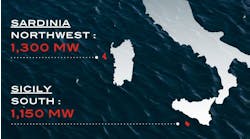Offshore staff
LAPPEENRANTA, Finland/LONDON, UK – The exploitation of wave energy for electric power may be on the brink of a new milestone, following a recent commercial breakthrough from CorPower Ocean.
At the same time, a new report from LUT University is said to describe the key role that wave energy can have in the UK’s future energy mix.
LUT University in Finland investigated a series of potential scenarios for the UK and Ireland to successfully transition towards a 100% renewable energy system by 2050. The best-performing scenario in terms of managing energy system cost and security forecast that the UK should seek to harness 27GW wave energy capacity.
With electricity consumption potentially trebling by 2050, the study shows the UK will need 27GW of wave energy to reach the lowest cost, net zero energy system.
The report comes just days after CorPower Ocean announced a major industry breakthrough after completing the first cycle of the ocean commissioning for its first commercial scale device.
Successfully verifying storm survivability and efficient power generation in normal sea states, CorPower’s C4 machine, deployed in the Atlantic off the coast of northern Portugal, has now overcome wave energy’s toughest historic challenges.
Marine Energy Council Policy Director Richard Arnold said: “CorPower Ocean’s commercial-scale breakthroughs in Portugal, demonstrates that wave energy is ready to realise its crucial role in a secure and cost-effective transition to net zero. LUT University’s compelling report reinforces the importance of wave energy in the UK’s energy transition. The UK has the maritime expertise, offshore engineering experience and supply chains to lead the world in harnessing wave energy. It is critical that the UK Government provides a clear route to market and supports the wave energy industry investing in coastal communities and beyond.”
Just days ago, the Marine Energy Council gave evidence to the UK Government’s Energy Security and Net Zero Select Committee inquiry into securing the domestic supply chain. “The Government has an opportunity to embed UK content in marine energy projects deployed in its waters and around the world,” added Mr Arnold. “We are now calling for a consistent route to market for wave energy with clear and ambitious targets of at least 300MW deployed by 2035.”
CorPower Ocean’s Head of Business Development Anders Jansson said: “We’ve taken giant leaps in recent years to prove wave energy technology at commercial scale. Our latest progression marks a crucial milestone for the sector addressing the two major obstacles which have hampered commercial adoption to date – survivability and efficient power generation in normal ocean conditions. It’s an inflection point which provides a firm signal of wave energy’s readiness for widescale adoption.”
LUT University’s research paper ultimately concluded that a broad combination of renewables must be applied in the UK with storage, sector coupling, and flexibility in order to reach 100% renewable energy. This will involve a mix of renewables including wind, solar, wave, tidal, geothermal, biomass and hydropower.
Christian Breyer, Professor for Solar Economy at LUT University, who led the study, said: “Wave power has a high potential globally, in Europe and in particular along the Atlantic coasts in the UK and Ireland. For the first time we could show the high economic attractiveness of wave power for the entire energy system, which has to be now enabled with the right general framework for wave power.”
03.06.2024



